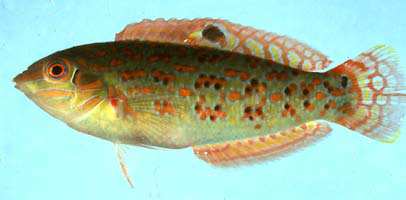| LABRIDAE |

Halichoeres timorensis, 6.0 cm SL
(photo by Richard Winterbottom)
|
Halichoeres timorensis (Bleeker, 1852) Timor Wrasse |
|
D IX, 11; A III, 11; P1 14; LLp 27; GR 18-20. Body moderately deep. A large curved canine present on each side at rear of upper jaw; lower jaw with 2 pairs of large slightly recurved canines anteriorly; pharyngeal teeth well developed, molariform. Predorsal scales reaching to a vertical at posterior edge of eyes; rest of head naked. Lateral line complete. Caudal fin slightly rounded; pelvic fins of males long, reaching or nearly reaching anus. Color: initial phase greenish grey on back, whitish below, with 5 longitudinal rows of small orange-yellow spots and short irregular orange-yellow bands; the bands often marked with groups of small black spots; a vertically elongate orange-yellow spot behind eye, edged anteriorly with black; dorsal fin with orangish diagonal bands and spots and a large ocellated black spot edged with pale blue between second and third soft rays; pectorals with a narrow red bar across base. Terminal males pale green to blue-green with blue-edged reddish to blackish spots arranged to form large irregular elliptical blotches with centers of ground color in a row along side of body; a second series of reddish black blotches on back; head with irregular reddish bands; a vertically elongate black spot behind eye; a large blackish blotch on dorsal fin between eight spine and second or third soft ray; pectorals with a narrow red bar across base. Size: maximum length about 14 cm. Distribution: Eastern Indian Ocean to western Pacific, from Sri Lanka to Indonesia and Papua New Guinea. Remarks: found in shallow coastal reefs to depths of at least 7 m. |
|
|